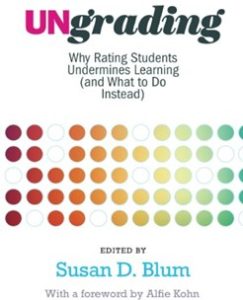Discussion 2 – Ungrading Introduction and Foundations & Models
UNgrading – Why Rating Students Undermines Learning (and What to Do Instead)
2025 Spring Scholarship of Teaching & Learning Book Discussion Series

In UNgrading, fifteen educators write about their diverse experiences going gradeless. Some contributors are new to the practice, and some have been engaging in it for decades. Some are in humanities and social sciences, some in STEM fields. Some are in higher education, but some are the K–12 pioneers who led the way.
Based on rigorous and replicated research, this book shows why and how faculty who wish to focus on learning, rather than sorting or judging, might proceed. It includes honest reflection on what makes ungrading challenging, and testimonials about what makes it transformative.
Discussion 2 – Introduction and Foundations & Models (pages 1 – 87) (February 14, 2025)
Discussion facilitated by Terence Govender
- Approach ungrading from a trusting perspective – that students are eager to learn
- Aim to increase students’ intrinsic motivation to participate
- Ungrading approaches are typically less hierarchical
- Should not be student vs. faculty dynamic since the emphasis shifts to feedback over grades
- Grades shouldn’t be used to control and filter students
- Grading can be inconsistent – first paper graded or last – faculty mood can unintentionally influence grades
- Do rubrics provide only an “illusion” of objectivity?
- The idea of the inconsistency associated with grades may not be fully mitigated with structured rubrics
- Ungrading improves transparency and limits controversy and tensions
- Less time grading – negotiating over points or partial credit
- Understand what institutions allow/not allow in terms of LMS gradebook
- Understanding the system better could also help with finding workaround solutions
- Difficulty in grading more creative assignments – how do those fulfill assessment outcomes required for governing bodies and accreditation
- Especially true for parental or administrative concerns about “rigor” or accountability without the familiar A–F structure
- Important to keep gradebook current so students can judge their own progress
- They might feel confused or lost without the benchmark of a traditional grade
- Learning is complex – feedback vs. grades
- Promote the notion that students learn from mistakes – for example, a “score” is not posted during practice – only during games
- Students gain more agency under an ungraded model
- We grade on student “knowing” not student “learning”
- Some students come into class with more foundational knowledge and don’t work hard; other students start further behind and work much harder
- When students transition between grading (or ungrading) approaches it may hurt them – if credits/grades don’t transfer
- Makes reciprocal transfer agreements murky – can “cure” transcripts with information like prior learning credits or competencies
- Feedback should be more specific, less subjective
- Less focus on grades; more focus on targeted, descriptive, authentic feedback and learning
- Alternative grading can take more time (variability)
- 8-week courses add unique challenges
- Consider starting small – perhaps one course – takes less time than doing an entire overhaul of all courses
- Incorporate ideas that fit with one’s personal style
- It is also not necessary to make major changes all at once. Kohn (Foreword xiii) “… the first tentative steps we take shouldn’t be the extent of our journey”.
